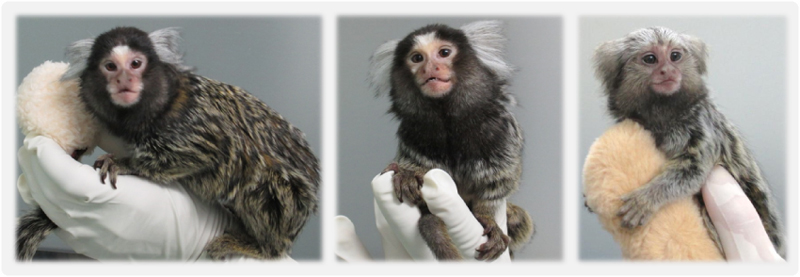Laboratory of Applied Developmental Biology
We have been developing genetic engineering technologies in the common marmoset, a small non-human primate species, and have succeeded in creating the world's first genetically modified marmoset in 2009.
In 2016, we succeeded in developing immunocompromised marmosets by target gene knockout using genome editing technology.
This immunodeficient marmoset demonstrates symptoms very similar to patients with X-linked severe combined immunodeficiency.
Using these genetic engineering technologies, various genetic disease models could be created and new therapies and drugs could be developed.
On the other hand, marmosets require a much longer breeding time compared to mice, establishing laboratory animal colonies of genetically modified marmosets and propagating it to many researchers requires approximately 10 years.
Therefore, we need new technology to accelerate the breeding of marmosets.
Recently, it has been shown that mechanisms of fertilization and embryogenesis between humans and mice are different and that development of humans and of non-human primates is similar.
Better understanding of embryogenesis in humans will be useful for treating congenital diseases in the future, however it is difficult to conduct research using human embryos or gametes because of ethical issues.
Therefore, we are currently conducting research to understand the embryogenesis of primates and to overcome the issue of breeding rate.
Immunodeficient marmoset models created by genome editing technology

※References
- Development of a non-invasive novel individual marmoset holder for evaluation by awake functional magnetic resonance brain imaging.
Seki F, Yurimoto T, Kamioka M, Inoue T, Komaki Y, Iriki A, Sasaki E, Yamazaki Y.
J Neurosci Methods. 2025 Feb 14;417:110390.
- Production of a heterozygous exon skipping model of common marmosets using gene-editing technology.
Sato K, Sasaguri H, Kumita W, Sakuma T, Morioka T, Nagata K, Inoue T, Kurotaki Y, Mihira N, Tagami M, Manabe R, Ozaki K, Okazaki Y, Yamamoto T, Suematsu M, Saido TC, Sasaki E.
Lab Anim (NY). 2024 Sep;53(9):244-251.
- Development of a noninvasive olfactory stimulation fMRI system in marmosets.
Yurimoto T, Seki F, Yamada A, Okajima J, Yambe T, Takewa Y, Kamioka M, Inoue T, Inoue Y, Sasaki E.
Sci Rep. 2024 Aug 1;14(1):17830. Published Erratum:Sci Rep.2024 Sep 23;14(1):21985.
- Development of a 3D tracking system for multiple marmosets under free-moving conditions.
Yurimoto T, Kumita W, Sato K, Kikuchi R, Oka G, Shibuki Y, Hashimoto R, Kamioka M, Hayasegawa Y, Yamazaki E, Kurotaki Y, Goda N, Kitakami J, Fujita T, Inoue T, Sasaki E.
Commun Biol. 2024 Feb 21;7(1):216.
- Generation of a Nonhuman Primate Model of Severe Combined Immunodeficiency Using Highly Efficient Genome Editing.
Sato K, Oiwa R, Kumita W, Henry R, Sakuma T, Ito R, Nozu R, Inoue T, Katano I, Sato K, Okahara N, Okahara J, Shimizu Y, Yamamoto M, Hanazawa K, Kawakami T, Kametani Y, Suzuki R, Takahashi T, Weinstein EJ, Yamamoto T, Sakakibara Y, Habu S, Hata J, Okano H, Sasaki E
Cell Stem Cell. 2016 Jul 7;19(1):127-38.
- Resequencing of the common marmoset genome improves genome assemblies and gene-coding sequence analysis.
Sato K, Kuroki Y, Kumita W, Fujiyama A, Toyoda A, Kawai J, Iriki A, Sasaki E, Okano H, Sakakibara Y.
Sci Rep. 2015 Nov 20;5:16894.
- Prospects for genetically modified non-human primate models, including the common marmoset.
Sasaki E
Neuroscience Research. 2015 Apr;93:110-5.
- Qualitative de novo analysis of full length cDNA and quantitative analysis of gene expression for common marmoset (Callithrix jacchus) transcriptomes using parallel long-read technology and short-read sequencing.
Shimizu M, Iwano S, Uno Y, Uehara S, Inoue T, Murayama N, Onodera J, Sasaki E, Yamazaki H.
PLoS One. 2014 Jun 30;9(6):e100936.
- Generating induced pluripotent stem cells from common marmoset (Callithrix jacchus) fetal liver cells using defined factors, including Lin28.
Tomioka I, Maeda T, Shimada H, Kawai K, Okada Y, Igarashi H, Oiwa R, Iwasaki T, Aoki M, Kimura T, Shiozawa S, Shinohara H, Suemizu H, Sasaki E, Okano H.
Genes Cells. 2010 Sep 1;15(9):959-69.
- Generation of transgenic non-human primates with germline transmission.
Sasaki E, Suemizu H, Shimada A, Hanazawa K, Oiwa R, Kamioka M, Tomioka I, Sotomaru Y, Hirakawa R, Eto T, Shiozawa S, Maeda T, Ito M, Ito R, Kito C, Yagihashi C, Kawai K, Miyoshi H, Tanioka Y, Tamaoki N, Habu S, Okano H, Nomura T.
Nature. 2009 May 28;459(7246):523-7.
